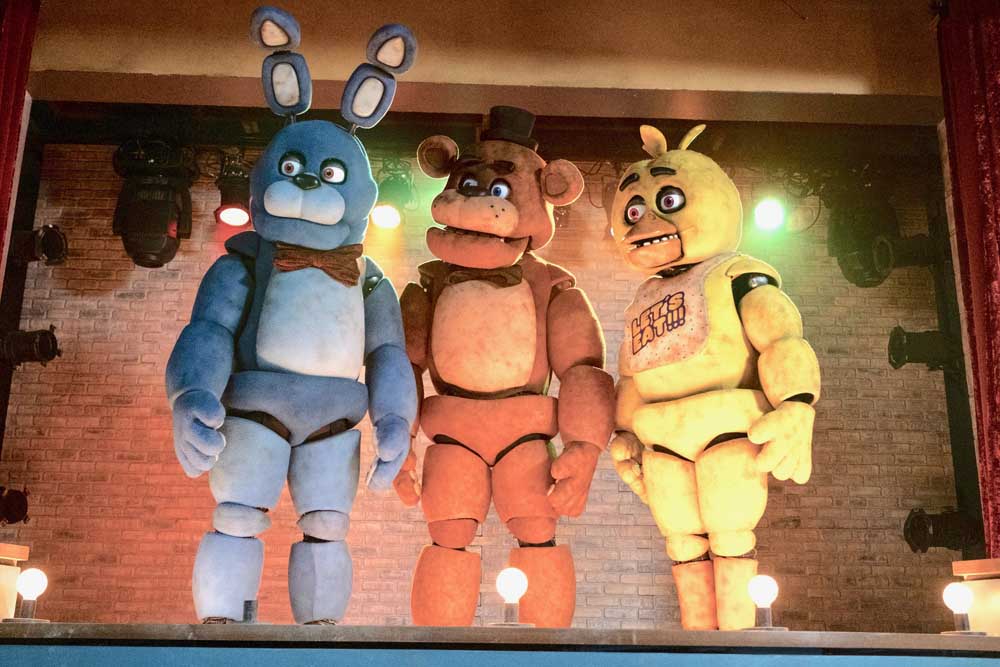From ‘Five Nights at Freddy’s’ to ‘Imaginary’: Why Blumhouse loves PG-13 horror
Published 3:00 am Tuesday, March 12, 2024

- From left, Bonnie, Freddy Fazbear and Chica in “Five Nights at Freddy’s,” one of the PG-13 horror films by Blumhouse Productions. The company’s next horror flick, “Imaginary,” releases soon.
Horror films have long been among the most reliable profit centers for Hollywood studios, even as other categories of film — like rom-coms, raunchy comedies and even superhero flicks — cycle through ups and downs. Within that ever-prolific heading is a subset of titles that have shown themselves to be a dependable way to get younger audiences to the local multiplex: the PG-13 horror movie.
Trending
This weekend Blumhouse Productions releases its latest effort, “Imaginary,” which follows a woman whose young stepdaughter befriends a creepy stuffed bear named Chauncey. Lionsgate is distributing the film, which is expected to open with about $10 million to $12 million at the domestic box office on an estimated production budget of $10 million, according to people who’ve reviewed pre-release audience surveys. That would be comparable to “Night Swim,” which opened to $11.8 million in January.
It’s the latest spooky PG-13 Blumhouse pic, following the success of “Five Nights at Freddy’s” ($291 million in global box office sales) and “M3gan” ($180 million). Both “Five Nights” and “M3gan” were distributed by Universal Pictures.
Blumhouse sees an opportunity to expand the market for the horror genre as the company itself grows through its merger with James Wan’s Atomic Monster. The Los Angeles-based producer is trying to make movies that young people can watch with other family members. The idea is that if the pictures work, they’ll hit not just with Gen Z, but with their parents and siblings as well.
Trending
“You wouldn’t think of these as ‘family movies,’ but the audience can be a family audience for these and that’s how something like ‘Five Nights at Freddy’s’ can gross almost $300 million at the box office,” Blumhouse President Abhijay Prakash told The Wide Shot. “When you have that PG-13 rating, it opens up the opportunity for parents, siblings and the child to all go, and that really came across in the data in a big way.”
PG-13 horror movies are not a recent phenomenon, of course, despite the broader genre’s subversive bent and the reputation for luridness and exploitation earned by the ‘80s slasher movies and their descendants. Joe Dante’s Christmas-themed horror-comedy “Gremlins,” rated PG, helped originate the PG-13 rating in 1984 after parents complained about its inappropriateness for smaller children.
Since then, films including “The Ring” and “A Quiet Place” have repeatedly reinforced the fact that studios can deliver genuine scares without pushing into hard-R-rated territory (though to this day, movies designed to scare the younger set raise questions about whether the Motion Picture Association is too lenient when it comes to violence and frightening imagery).
And teenagers have long been a key demographic for the genre, regardless of the MPA designation. Think of how many movies became cult classics thanks in large part to the slumber party audience. Plus, horror is typically inexpensive to produce, making profitability easier to achieve, as is the Blumhouse way.
Part of horror’s endurance at the box office has been attributed to the unique experience of seeing something scary in a theater with a group, which is hard to replicate on the couch. What the survey data suggests is that the crew in question “doesn’t necessarily need to be your peers and friends, it can also be your family,” said Prakash.
Not every movie is going to hit the mark. “Lisa Frankenstein,” a horror-comedy from Focus Features, hasn’t exactly sent folks rushing to the cinema. But we can surely expect to see more PG-13 frights in the coming years, especially with these movies becoming family affairs in some cases.









